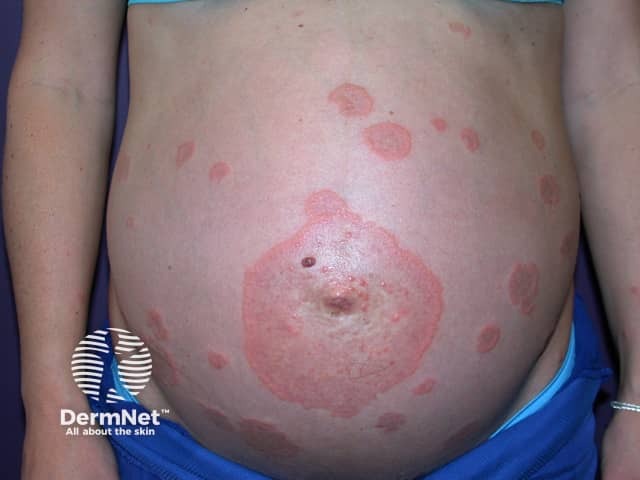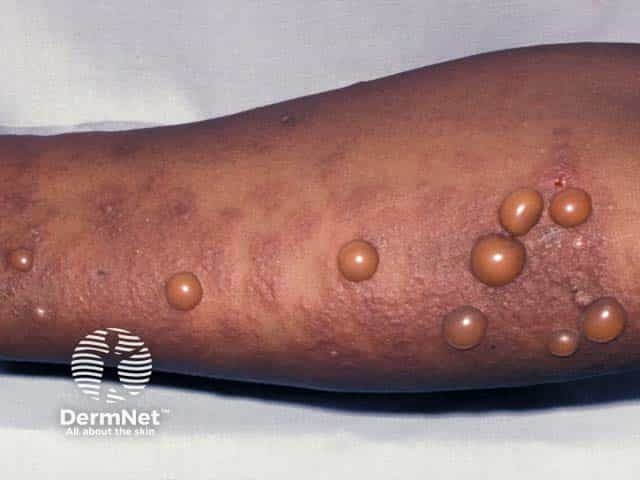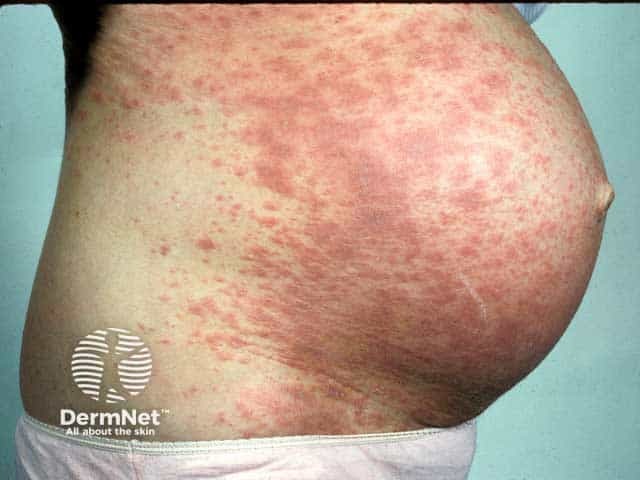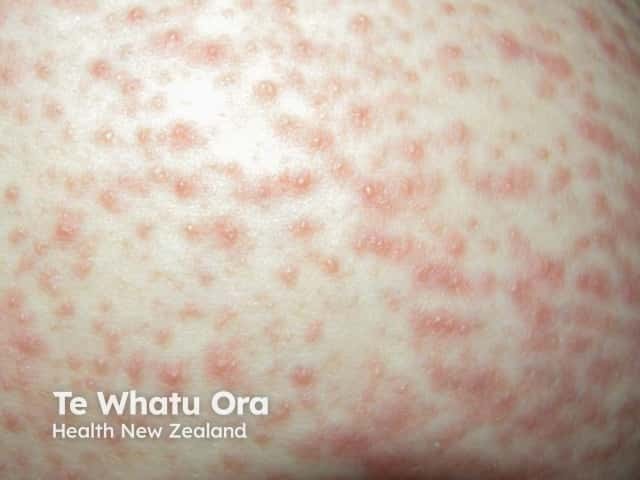Main menu
Common skin conditions

NEWS
Join DermNet PRO
Read more
Quick links
Pemphigoid gestationis — extra information
Pemphigoid gestationis
Author: Vanessa Ngan, Staff Writer, 2003. Updated: Dr Amy Stanway, Dermatologist, Tauranga, New Zealand. Copy edited by Gus Mitchell. September 2021.
Introduction Demographics Causes Clinical features Complications Diagnosis Differential diagnoses Treatment Outcome
What is pemphigoid gestationis?
Pemphigoid gestationis is a rare pregnancy-associated autoimmune blistering skin condition.



Who gets pemphigoid gestationis?
Pemphigoid gestationis affects women of all races during pregnancy or shortly after delivery. The median age of onset is 26–32 years (range 17–41 years). It may develop during the first pregnancy or appear for the first time in a multiparous woman.
Pemphigoid gestationis occurs in approximately 1 in 50000 pregnancies. It may rarely present in association with trophoblastic tumours such as choriocarcinoma or hydatidiform mole.
Pemphigoid gestationis usually develops during the second and third trimesters of pregnancy or the immediate postpartum period. Onset may be earlier in subsequent pregnancies.
What causes pemphigoid gestationis?
Pemphigoid gestationis is an autoimmune disease, which means a woman’s immune system is attacking a normal component of her own skin.
In pemphigoid gestationis, PG factor, a specific immunoglobulin type G (IgG) in the blood, binds to the BP-180 protein located in the basement membrane of the skin leading to tissue damage and blistering. The usual function of BP-180 is to help stick the epidermis and dermis together, so the blister split is in the basement membrane [see Structure of normal skin].
BP-180 protein is also found in the placenta. It appears it is the placenta, not the skin, that triggers the autoimmune response in pemphigoid gestationis, which explains why this condition starts in pregnancy.
Pemphigoid gestationis is strongly associated with maternal MHC class II antigens haplotypes HLA-DR3 and HLA-DR4. As in other autoimmune conditions, pemphigoid gestationis is associated with an increased risk of other organ-specific autoimmune diseases, in particular Graves disease [see Pretibial myxoedema].
What are the clinical features of pemphigoid gestationis?
Pemphigoid gestationis typically presents as an intensely itchy urticaria-like rash during mid to late pregnancy (13–40 weeks gestation).
- Initially there are itchy red bumps around the belly button.
- Within days to weeks, the rash spreads to other parts of the body, including the trunk, buttocks, and arms. The face, scalp, palms, soles, and mucous membranes are not usually affected.
- After 2-4 weeks, large, tense blisters filled with clear yellowish fluid may form. Some patients may have no blisters but instead have plaques of inflamed skin.
Distribution of rash in pemphigoid gestationis



Features of the pemphigoid gestationis rash



Pemphigoid gestationis in skin of colour



What are the complications of pemphigoid gestationis?
- Premature delivery or small-for-dates baby — the risk of this correlates with the severity of the pemphigoid gestationis.
- Trans-placental transfer of PG factor from the mother to the fetus causes transient blistering on the infant in approximately 10% of affected pregnancies. Blister formation in the baby spontaneously resolves with the natural clearance of maternal antibodies (3–4 months).
- Secondary bacterial infection of the skin, which may leave scarring.
How is pemphigoid gestationis diagnosed?
Pemphigoid gestationis is usually a clinical diagnosis when the features are typical, but in the early stages it can be indistinguishable from other pregnancy eruptions. Blood tests and skin biopsy may be required.
- Histology — dermal perivascular inflammatory infiltrate, subepidermal blister
- Direct immunofluorescence — linear C3 staining along the dermo-epidermal junction is present in all cases. Staining of salt-split skin shows the antibodies localise to the roof of the blister (epidermal side).
- Blood tests — indirect immunofluorescence for circulating autoantibodies can be used to distinguish pemphigoid gestationis from other autoimmune blistering disorders
What is the differential diagnosis for pemphigoid gestationis?
- Polymorphic eruption of pregnancy
- Pustular psoriasis of pregnancy
- Bullous pemphigoid
- Epidermolysis bullosa acquisita
What is the treatment for pemphigoid gestationis?
The aim of treatment in pemphigoid gestationis is to relieve itch, prevent blister formation, and treat secondary infection.
- Topical steroids are used in mild disease whilst systemic corticosteroids are necessary in more extensive cases. Minimum effective doses should be used to reduce the risk of side effects to both mother and fetus. When the disease improves, the dose can usually be reduced, but should be increased in time to prevent a postpartum flare.
- Oral antihistamines may be used to relieve itch.
- If unresponsive to oral corticosteroid, third-line treatments include:
- After delivery, a greater range of immunosuppressive treatment may be used if required.
- Treatment of associated gestational trophoblastic disease may result in remission of pemphigoid gestationis.
What is the outcome for pemphigoid gestationis?
Pemphigoid gestationis follows a fluctuating course of exacerbations and remissions during pregnancy. It frequently improves in late pregnancy followed by a flare at the time of delivery in 75% of patients. After delivery, the lesions usually resolve within weeks or months. Rarely, pemphigoid gestationis can persist for several years. A systematic review found 80% of women were in complete remission 9 months post-partum, but half were still requiring treatment.
Pemphigoid gestationis usually recurs with subsequent pregnancies, although there may be unaffected pregnancies in between. Skin changes may recur with menstruation and hormonal contraception.
Bibliography
- Ceryn J, Siekierko A, Skibińska M, Doss N, Narbutt J, Lesiak A. Pemphigoid gestationis - case report and review of literature. Clin Cosmet Investig Dermatol. 2021;14:665–70. doi:10.2147/CCID.S297520. Journal
- Genovese G, Derlino F, Cerri A, et al. A systematic review of treatment options and clinical outcomes in pemphigoid gestationis. Front Med (Lausanne). 2020;7:604945. doi:10.3389/fmed.2020.604945. Journal
- Huilaja L, Mäkikallio K, Tasanen K. Gestational pemphigoid. Orphanet J Rare Dis. 2014;9:136. doi:10.1186/s13023-014-0136-2. Journal
- Kukkamalla RM, Bayless P. Pemphigoid gestationis. Clin Pract Cases Emerg Med. 2019;3(1):79–80. doi:10.5811/cpcem.2018.11.39258. PubMed Central
- Sävervall C, Sand FL, Thomsen SF. Pemphigoid gestationis: current perspectives. Clin Cosmet Investig Dermatol. 2017;10:441–9. doi:10.2147/CCID.S128144. Journal
On DermNet
- Blistering skin conditions
- Bullous pemphigoid
- Epidermolysis bullosa acquisita
- Polymorphic eruption of pregnancy
- Pustular psoriasis of pregnancy
- Skin changes in pregnancy
Other websites
- Pemphigoid gestationis — Medscape
- International Pemphigus and Pemphigoid Foundation
- Pemphigoid gestationis — British Association of Dermatologists
- Australasian Blistering Diseases Foundation
